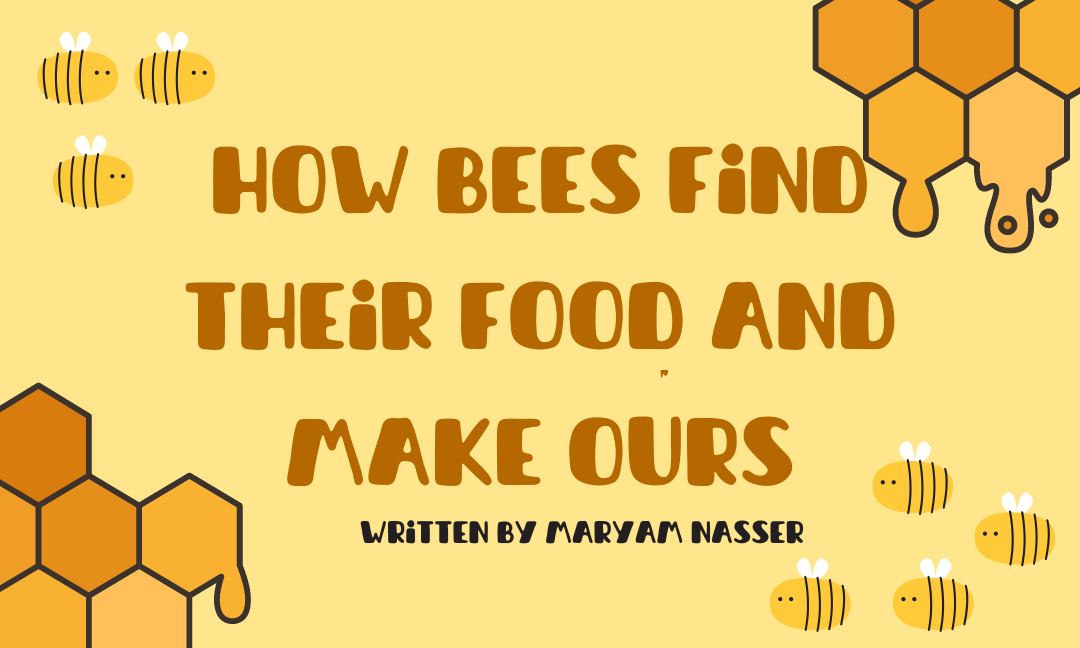Written by: Maryam Nasser
Edited by: Yara
Designed by: Kiritika Rana
Published by: Maryam Khan
Honey is one of nature’s many beauties. First of all, it is a rich, sweet golden syrup that enhances and is the key ingredient in many desserts. Secondly, it is commonly used to treat coughs and colds. Thirdly, the way it’s made and its maker are absolutely fascinating!
How do bees find nectar?
You have probably seen bees buzzing around a large beehive. Bees live together in their colonies and honeybees work together as a team in order to find food and make honey. Since flowers vary in the amount of nectar they have, when a honeybee finds a good area with lots of nectar-rich flowers, they communicate with the colonies so they can go there to obtain nectar.
The Honeybee Dances!

In order to tell the other honeybees where to go, bees use two types of dances called the Waggle Dance and the Circle Dance. Here we will just delve deeper into one of the previously mentioned dances.
The Waggle Dance occurs when a honeybee waggles from side to side while going in a straight line. Then, the bee circles back to its starting point and repeats! The length of the bee waggle dance corresponds to how far away the nectar source is.
Even more fascinating is how the honeybee communicates the direction in which the other honeybees should fly to get the nectar. Basically, in their hives, honeybees are aware of which direction is “up”. So, a bee performs their dance from a certain angle, from the “up”. When the other bees fly out of the hive, they use the sun as their “up” marker and fly away at the angle that the bee danced away from.
Wow! Now the other honeybees know the location of the nectar and can head there!
How do honeybees make honey?
One common theme you will notice about bees is teamwork, teamwork, teamwork. So, let’s take you through the team effort to produce honey.
Firstly, a bee needs to obtain nectar. When a worker honeybee reaches a good flower, they suck nectar from the nectary of the flower through their tongue, which functions like a straw. Importantly, the bee has a specific stomach separate from its “eating” stomach to store honey. In this stomach, the sugars in the nectar begin to break down. Back in the colony, the nectar is given to another bee, known as house bees (typically younger bees), who place the nectar in a honey cell ⎯those hexagons that make a honeycomb. Then, the house bee works to dry the honey by flapping its wings to produce warm air. Interestingly, a beeswax lid is made to cover the dry nectar (cool!), and in winter, when nectar is scarce, their small honey capsules can be opened so that the honey may be enjoyed!
Ultimately, the journey to getting a sweet, satisfying spoonful of honey is incredible, sophisticated, and inspiring. So the next time you take a spoonful of it or drizzle it over your pancakes, take a moment to appreciate the beautiful way nature has formed this special golden gift, just for you.

Don’t feel shy to marvel over the incredible and varying types of hues ⎯ a result of the diverse flowers that honeybees extract nectar from. Picture from Wallpaper Flare.910 ×
Works Cited
Arizona State University. (n.d.). Bee Waggle Dance. Ask A Biologist |. Retrieved May 28, 2023, from https://askabiologist.asu.edu/bee-dance-game/introduction.html
Southern Cross University. (2020, August 21). How do bees make honey? Southern Cross University. Retrieved May 28, 2023, from https://www.scu.edu.au/engage/news/latest-news/2020/how-do-bees-make-honey.php

